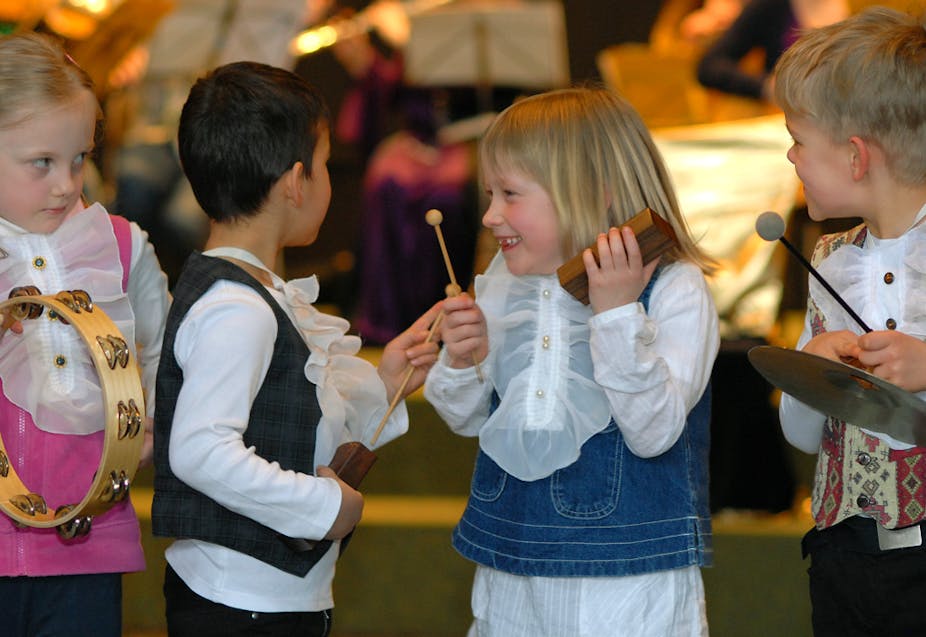The Conversation is running a series, Class in Australia, to identify, illuminate and debate its many manifestations. Here, Katrina McFerran discusses how access to music education can reaffirm social distinctions between the “haves” and the “have nots”.
When some parents make decisions about where to send their child for an education, one of the primary issues for consideration can and should be whether or not the school has a decent music program.
As the 2012 Gonski report famously highlighted, inequity is entrenched in the Australian school system. A comparison of the two sectors undertaken by the Music Council of Australia showed that 88% of private schools offer a meaningful music education, while a measly 23% of government schools provide the equivalent.
When contemplating the private school sector, it would be reasonable to assume music programs differ by a matter of degree. Is music centralised in the school curriculum, with impressive annual performances that incorporate band, orchestra, singers and a production, or is there merely a decent music department?
The decision to access a public school comes with no such guarantees. The question is whether or not there is any kind of arts program, and if there is, whether music is a regular feature of it, or something that students might access for one or two terms a year, alternating with drama or fine art.
The implications of this kind of disparity in the provision of music education in Australian schools reach beyond arts and culture.
At a fundamental level, the lack of dynamic music programs means there are less opportunities for diverse student bodies to participate together in creative and meaningful activity.
While this might be less of a problem for those students who are able to engage in sporting activities, students who do not play footy or netball will have little chance to be involved and acknowledged.

The core business of schools is unquestionably the acquisition of academic knowledge, but the social function of these institutions is also well understood. Schools are where our children spend the greatest proportion of their waking lives, and if music is not available, then the possibilities for transcending the presumptions that others hold about each child’s capacity is severely limited.
So let’s consider how this might play out in reality, with a fictional character called Jennifer. Jennifer has just moved schools following her parents’ separation and, at the age of 14, is struggling to establish an identity in her new school.
There are no lunch-time programs and the only opportunity to relate to her peers is in the classroom, where she feels too intimidated to speak up. The well-being department offers regular programs for the empowerment of girls, and to address grief and loss issues, but Jennifer doesn’t want to identify through her problems. She simply needs an opportunity to join in.
Enter an active music program. If the music teacher, or an outside facilitator, was to offer an engagement oriented music program, everything could change for Jennifer. Instead of being isolated, she could sing in the lunch time choir. Instead of being passive, she could contribute to the school production.
And even more signficantly, for those students who struggle with profound challenges that impact their ability to truly participate in the school culture, these opportunities can be the difference between resilience and despair.
Music promotes resilience and self-belief
One relevant definition of resilience is offered by family therapist Dr Michael Ungar at Dalhousie University, who describes the symbiosis between an individual’s capacity for reaching out for help, and the necessary conditions that provide opportunities for help to be available.
Without an alternative platform for engaging in school life, students are dependent upon either scholarly or sporting pursuits. Not all children thrive in these conditions, and music is an alterate way of triggering the release of endorphins and dopamines that provide young people with the high of positive participation.
It is not just social and emotional wellbeing that is impacted by this kind of active and creative participation.

The very same qualities that are promoted in shared music making experiences are those that are proven to promote successful learning in Professor of Education John Hattie’s synthesis of research relating to school achievement.
Inspiring relationships between teachers and students, and students and their peers, are critical to learning. What music can promote is opportunities for students to develop an identity as learners and leaders, even if that is not the case in the academic classroom.
Many young people can succeed in music activities even when they are not able to display their abilities in cognitive tasks. Success in one area can promote a belief in oneself, or in a peer, that they “can do it”.
Music education is a right
A decent music education should be the right of all children, as stated by the UN Convention on the Rights of Children and also the Convention on the Rights of People with Disabilities.
All children have social and cultural rights, and children with disabilities must be offered:
conditions which ensure dignity, promote self-reliance, and facilitate the child’s active participation in the community.
Music is not just “auditory cheesecake”, as American psychologist Steven Pinker once infamously suggested when deliberating the evolutionary function of music.
It is a necessary and essential condition that is omnipresent in all human cultures, perhaps because of the opportunities it affords for connectedness with others.
Without equitable access we reaffirm social distinctions between those who have, and those who have not.
Further reading:
If resilience is the question, is music the answer?
The Conversation is running a series on Class in Australia. See the other instalments here.

